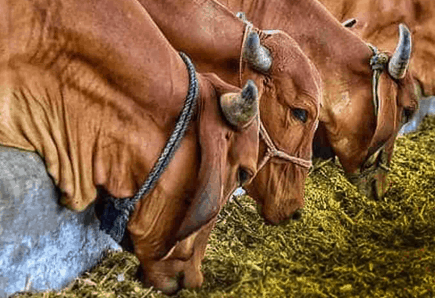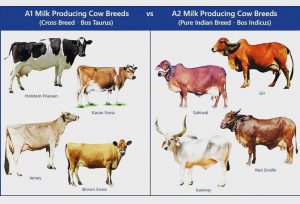
Selection of Dairy Cattle for Profitable Dairy Farming
Proper selection is the first and the most important step to be adopted in dairy farming. Records are the basis of selection and hence proper identification of animals and record-keeping is essential. Cross-breed animals with an exotic inheritance of about 50 percent are preferable. This preference is based on the comparison of the performance of the animals with different percentages of exotic inheritance. Fifty percent of the native germplasm is helpful to retain the adaptability, heat tolerance and disease resistance traits of local animals, in crossbreeds. The utilization of the Zebu (Sahiwal) germplasm in the formation of breeds like Australian Friesian Sahiwal (50% of Holstein and 50% Sahiwal) and its international recognition as a breed for the tropics is an example.
Maintaining animals sustainable in the situation is the best policy. Bringing animals from different agro-climatic conditions causes problems due to non-adjustment in many cases. In case, the purchase becomes absolutely essential it should be from similar environmental conditions as far as possible.
General selection procedures for dairy breeds
Selection of Dairy Cows
Selecting a calf in calf show, a cow in cattle show by judging is an art. A dairy farmer should build up his own herd by breeding his own herd. Following guidelines will be useful for the selection of a dairy cow.
• whenever an animal is purchased from a cattle fair, it should be selected based upon its breed characters and milk-producing ability
• History sheet or pedigree sheet which are generally maintained in organized farms reveals the complete history of animal
• The maximum yields by dairy cows are noticed during the first five lactations. So generally selection should be carried out during First or Second lactation and that too is the month after calving.
• There successive complete milking has to be done and an average of it will give a fair idea regarding production by a particular animal.
• A cow should allow anybody to milk and should be docile.
• It is better to purchase the animals during the months of October and November.
• The maximum yield is noticed until 90 days after calving.
• Immediately after the release of the loan purchase the stock from a reliable breeder or from the nearest livestock market.
• Select healthy, high yielding animals with the help of the bank’s technical officer, veterinary/animal husbandry officer of State government/ Zilla Parishad, etc.
• Purchase freshly calved animals in their second/third lactation.
• Before purchasing, ascertain actual milk yield by milking the animal three times consecutively.
• Identify the newly purchased animal by giving a suitable identification mark (ear tagging or tattooing).
• Vaccinate the newly purchased animal against disease.
• Keep the newly purchased animal under observation for a period of about two weeks and then mix with the general herd.
• Purchase a minimum economical unit of two milch animals.
• Purchase the second animal/second batch after 5-6 months from the purchase of the first animal.
• As buffaloes are seasonal calvers purchase them from July to February.
• As far as possible purchase the second animal when the first animal is in its late stage of lactation and is about to become dry, thereby maintaining continuity in milk production vis-a-vis income. This will ensure the availability of adequate funds for maintaining the dry animals.
• Follow judicious culling and replacement of animals in a herd.
• Cull the old animals after 6-7 lactations.
Breed Characteristics of High Yielding Dairy Cows
• Attractive individuality with femininity, vigour, harmonious blending of all parts, impressive style and carriage
• The animal should have the wedge-shaped appearance of the body
• It should have bright eyes with lean neck
• The udder should be well attached to the abdomen
• The skin of the udder should have a good network of blood vessels
• All four quarters of the udder should be well demarcated with well-placed teats.
Selecting Breeds for Commercial Dairy Farm –Suggestions
• Under Indian condition, a commercial dairy farm should consist of a minimum of 20 animals (10 cows, 10 buffaloes) this strength can easily go up to 100 animals in a proportion of 50:50 or 40:60. After this, however, you need to review your strength and market potential before you chose to go for expansion.
• Middle class health-conscious Indian families prefer low-fat milk for consumption as liquid milk. It is always better to go for a commercial farm of mixed type. (Crossbreed, cows and buffaloes kept in separate rows under one shed).
• Conduct a thorough study of the immediate market where you are planning to market your milk You can mix milk from both types of animals and sell as per need of the market. Hotels and some general customers (can be around 30%) prefer pure buffalo milk. Hospitals, sanitariums prefer cow’s milk.
Selection of Cow Breeds for Commercial Farm
• Good quality cows are available in the market and it cost around Rs.4500 to Rs.5000 per liter of milk production per day. (E.g. Cost of a cow producing 10 liters of milk per day will be between Rs.45000 to Rs.50,000).
• If proper care is given, cows breed regularly giving one calf every 13-14 month interval.
• They are more docile and can be handled easily. Good milk yielding crossbreeds (Holstein and Jersey crosses) has well adapted to the Indian climate.
• The fat percentage of cow’s milk varies from 3-5.5% and is lower then Buffaloes.
BREEDS OF DAIRY CATTLE AND SELECTION OF COWS
Breeds of Dairy CATTLE-

Indigenous Cows –
• The Indian milch breeds are Sahiwal, Red Sindhi, Gir.
• The milk production is on an average of 1600 kg per lactation.
Sahiwal
• Originates from Montgomery district of Pakistan
• More populations of these breeds are found in Punjab, Haryana, U.P, Delhi, Bihar and M.P.
• Milk yield ranges from (1350 kg to 2100 kg).
• Age at first calving (32-36 months )
Red Sindhi
• Belongs to Kohistan, Sindh province in Pakistan.
• It is one of the most distinctive cattle breeds in India.
• Mainly available in Punjab, Haryana, Karnataka, Tamil Nadu, Kerala and Orissa.
• Milk yield varies from (1700 kg -3400 kg per lactation).
Gir
• Mainly found in the Gir forest areas of South Kathiawar.
• Milk yield varies from (900 -1600 kg in lactation)
Exotic Breeds of Dairy Cow
Jersey
• Developed from the island of jersey, like France.
• The Jerseys coat colour varies from a very light gray to a very dark fawn or a shade that is almost black.
• Age at first calving: 26-30 months.
• Milk yield – 5000-8000 kg.
• Jersey yields 20 liters/day whereas, crossbred jersey cow gives 8-10 liters/day.
• Well developed to the climatic condition of India especially hot and humid areas.
Holstein Friesian
• This breed is originated in Holland.
• Holsteins are large capacious animals with colour patterns of black and white or red and white.
• Milk yield – 7200 – 9000 kg the best diary breed among exotic cattle regarding milk yield.
• On average it gives 25 liters of milk per day, whereas a crossbreed H.F. cow gives 10 – 15 liter per day.
• It can perform well in coastal and delta areas.
Jamshedpur, Jharkhand, India
Mob. No.:9431309542, Email:rajeshsinghvet@gmail.com
